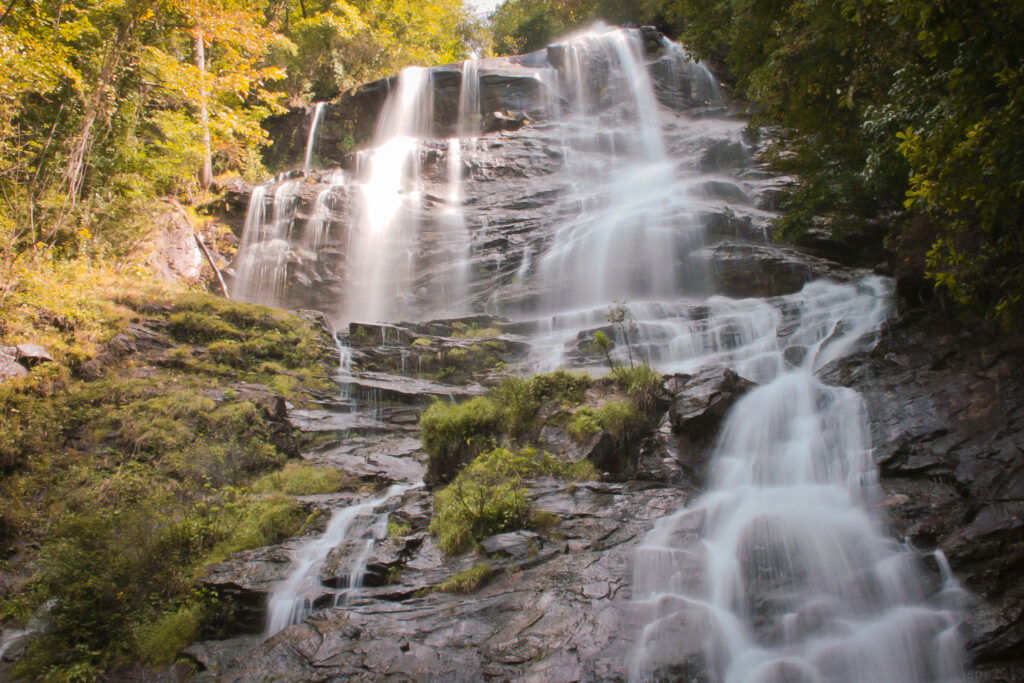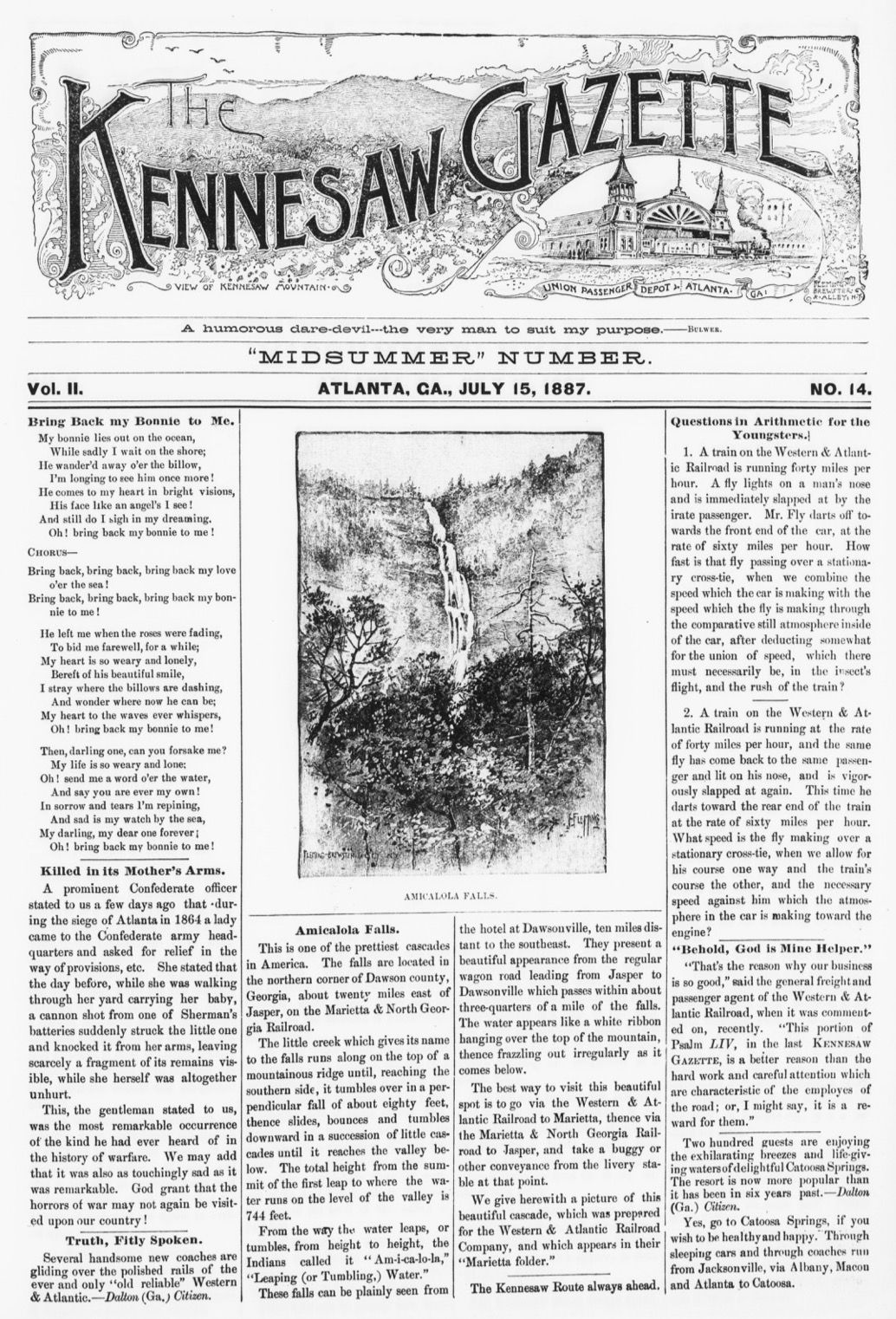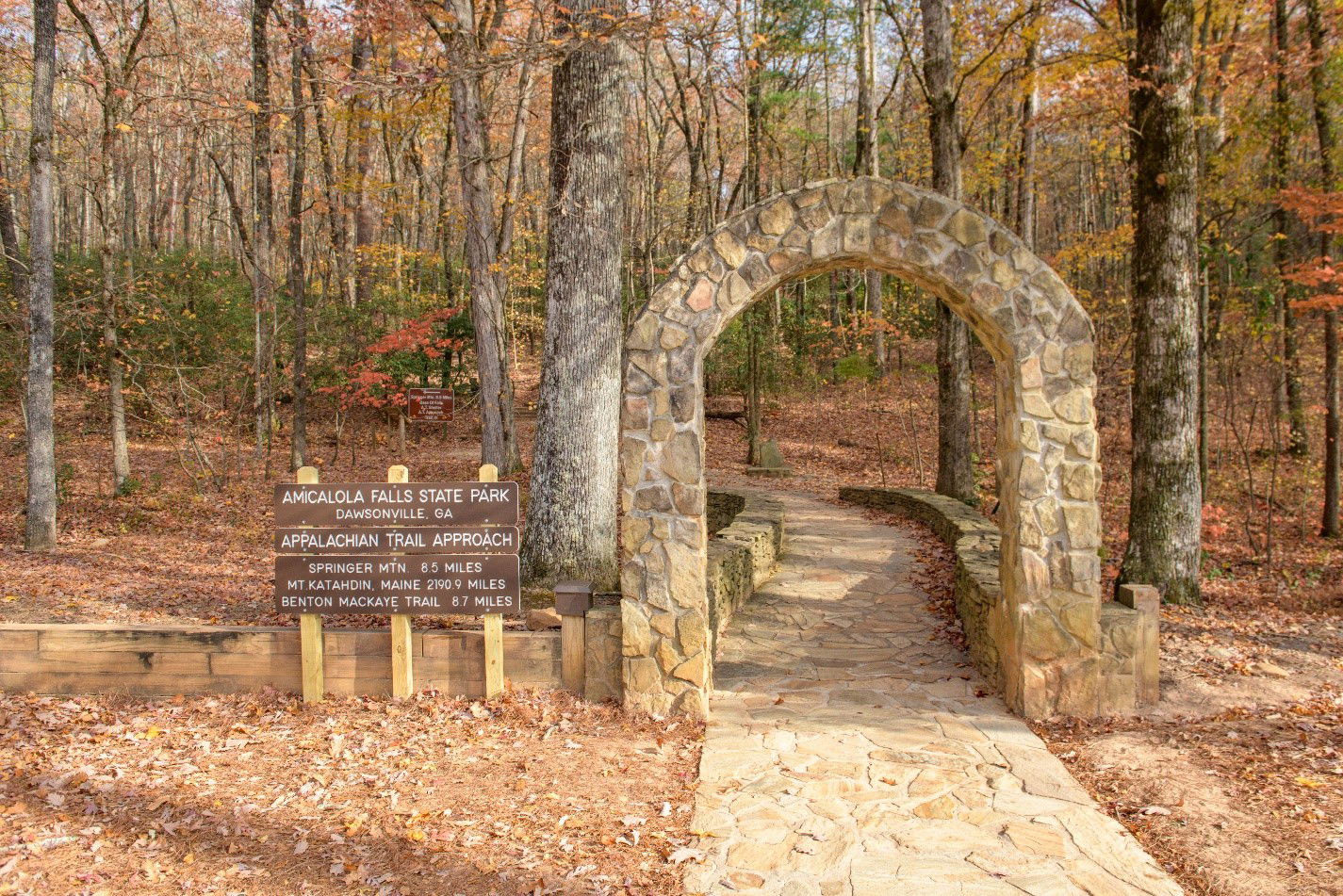Amicalola Falls is the highest waterfall in Georgia and among the highest in the southeast. The falls, which are classified as tiered horsetail falls due to their characteristic contact with rock surface, are the main feature of the popular Amicalola Falls State Park and are recognized as one of the Seven Natural Wonders of Georgia.
Located in northeastern Dawson County, the upper east fork of Amicalola Creek, Little Amicalola Creek, plummets down the eastern side of Amicalola Mountain in three-tenths of a mile over multiple tiered cascades. The state park has long recorded the falls at a staggering 729 feet, which reflects an approximate elevation change from the top of the falls to the visitor center at the base of the park downstream. But topographic measurements put the falls’ cumulative vertical drop from its highest point to its plunge pool (called a “reflection pool” by the park) closer to around 580 feet, while remote sensing data put the falls at around 450 feet.

The name derives from the Cherokee words ama, meaning “water,” and kalola, meaning “tumbling” or “rolling.” Established Cherokee communities lived along the Amicalola and greater Etowah watersheds throughout the early nineteenth century until state and federal troops forcibly displaced them in the late 1830s.
The first account of the falls made by a white settler came in 1832 by William W. Williamson, a subcommander of the Georgia Guard appointed to protect gold mines in north Georgia. Williamson had been ordered to the region by Governor Wilson Lumpkin to assess the Cherokee response to the Supreme Court’s Worcester v. Georgia decision. The subcommander wrote the governor that he “discovered a Waterfall perhaps the greatest in the world” and “the most majestic scene that I have ever witnessed or heard of.”
Sometime during the mid-nineteenth century Bartley Crane became the first known white Georgian to settle near the foot of the falls, where he operated a grist mill, farm, and eventually a hospitality service and distillery. Little is known about the mill site or its operations. Crane’s two sons evidently took part in their father’s distillery operations, as the Cherokee Advance reported in May 1893 that the three had been arrested for moonshining. Upon Bartley Crane’s death in 1915, the property passed to his younger son, John Hunter Crane, who apparently operated a general store, a barber shop, and rented cabins at the base of the falls. By 1860 the Methodist Episcopal Church had formally established a campground in the area, but the site was used for gatherings as early as 1846, and meetings continued throughout the nineteenth century.
By the late 1860s travel handbooks described the falls’ majesty. The 1867 Appletons’ Handbook of American Travel provided accounts from the bottom and top of “the Falls of Amicalolah.” In 1876 the Thomaston Herald remarked on the beauty of the falls, calling it “perhaps the grandest scene in the South,” one that “resembles a stream of melted silver.” Other publications like the Savannah Recorder and the Atlanta Weekly Constitution made short mention of the “beautiful falls” or their significance to the Cherokee while an 1885 brochure on Marietta mentioned the falls among noteworthy regional sites.

By the early 1880s Amicalola Falls had become a tourist destination as interest in natural public recreation areas surged following the founding of Yellowstone National Park in 1872. In 1883 Athens’s Banner Watchman published a thorough account of men, women, and children who travelled to the falls for an overnight “excursion” to Crane’s property that included a picnic, a hike to the top of the falls, and caving. Four years later the front page of the Kennesaw Gazette depicted an illustration of the falls with an account of the scenic area and instructions for traveling there via rail and buggy. Throughout the 1890s and 1900s papers across the state shared accounts from residents who travelled to the falls for exploration, rejuvenation, or recreation.
In May 1922 a delegation of government officials, members of congress, and highway and forestry experts travelled to Amicalola Falls to assess the site’s potential for a national park. On May 31 The Gainesville News reported that “Except in the far West, where millions have been expended in the development of Yellowstone and Yosemite National parks, there are no really great playgrounds for the American people… It is hoped that in the near future, the present Nantahala and Cherokee forest reserves will be expanded and developed, and there will be established right here in Northeast Georgia a forest reserve and public park that will rival those in the West.” The committee also evaluated forest lands surrounding the falls for the expansion of trails and roads, the establishment of army camps and artillery ranges, and the development of water power.
The proposed national park never developed, but the next month, in June 1922, officials at the forestry department called for the construction of a highway system into a region boosters now described as an “American Switzerland.” Eventually the state employed convict labor to build the massive new road system connecting the falls to other cities and natural spaces across north Georgia. In 1921 the first National Conference of State Parks established the need for recreational outlets at the state level and by 1931 the Georgia State Park System was established with the founding of Vogel and Indian Springs, first called “Forest Parks.” In August 1938 a committee of businessmen, civic leaders, and Governor E. D. Rivers moved to acquire the falls, and Amicalola Falls State Park opened to the public in 1940.

The state highway department dammed Little Amicalola Creek the following year, creating a lake at the top of the falls. But after the 1977 collapse of the Kelly Barnes Dam in Stephens County resulted in thirty-nine deaths, inspectors ruled that the Amicalola Dam was insufficient, and it was drained that same year. The Amicalola Falls Lodge opened in 1991 just a half mile from the falls and underwent renovation in 2017 and further overhauls to its exterior in 2019. The park’s visitor center, also named for the falls, was replaced with an entirely new structure in 2023 after more than fifty years.
The falls can be viewed in several ways. Visitors travelling by car can access the top of the falls via Amicalola Falls State Park Road, which leads to a parking area adjacent to the upper viewing platform. The falls are also accessible by foot via several hundred stairs that originate at the base of the falls, and they are an early feature of the first leg of the eight-mile Appalachian Approach Trail to Springer Mountain, the southern terminus of the Appalachian Trail. For long-distance hikers beginning their journey north at the archway behind the Amicalola Falls Visitor Center, scaling the height of Amicalola Falls via the massive stairway has become a rite of passage.

































